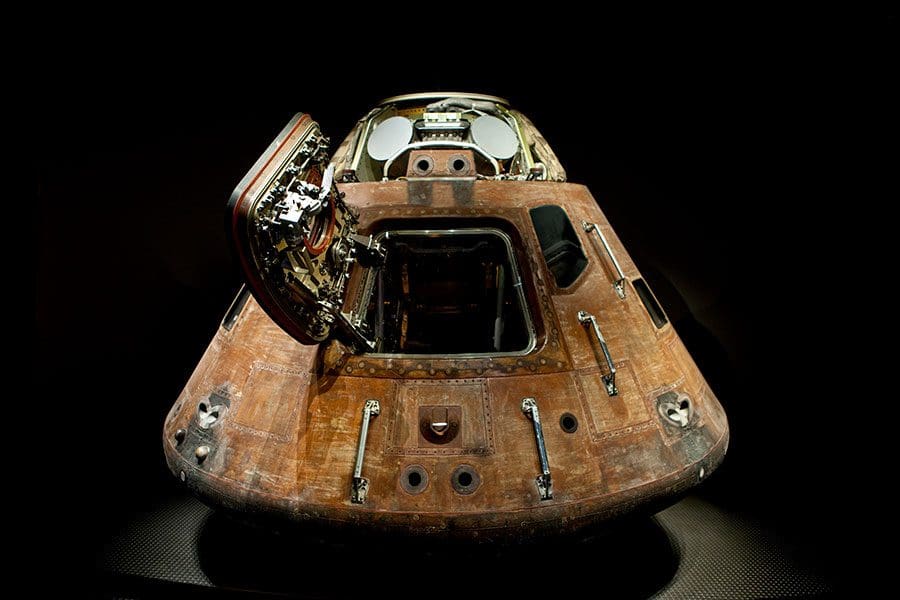
By Mary Ann DeSantis
Near & Far: Rockets’ red glare around the South


This month marks the 50th anniversary of the Apollo 11 moon landing and space centers around the South are launching special programs and events to mark the occasion.
Story: Mary Ann Desantis // Photos Courtesy of the Kennedy Space Center
On July 20, 1969, millions of us held our collective breaths as Neil Armstrong emerged from the Apollo 11 Eagle lunar module at 4:17 p.m. and took a giant leap for mankind on the moon. Everyone knows the Kennedy Space Center was ground zero for the Apollo launches, but what may be surprising is the crucial role other Southern destinations played in America’s space race.
Kennedy Space Center Visitor Complex

Merritt Island, Florida
kennedyspacecenter.com
If you’ve not been to KSC in recent years, you’ll be surprised by how much the facility has grown. The KSC Visitors Complex has done a remarkable job balancing history with its theme park attraction, which delights kids of all ages. Lest you forget, it is still a working facility where scientists and engineers are developing new projects, and a bus tour takes you throughout the working spaceflight center. On the way to the Apollo/Saturn V Center, you will get a drive-by of the historic Launch Pad A, used for both Apollo and shuttle missions and now Space X; the modified Launch Pad B, which is used for NASA’s Space Launch System; and the massive Vehicle Assembly Building.
While the Shuttle Atlantis Launch Experience may be the most popular KSC attraction, this is the summer to spend more time at the Apollo/Saturn V Center, where you can stand beneath the largest rocket ever flown and even touch a moon rock. Be sure to allow at least two hours for the bus tour and a visit to the center, which is located east of the visitor complex and only accessible by the KSC bus tour.
This month, visitors will be able to get an up-close look at Lunar Module 9, which was previously suspended from the ceiling of the Apollo/Saturn V Center. LM 9 is one of only three remaining lunar modules designed for mission use, and it is landing once again—this time on the ground floor of the center.
As part of the 50th anniversary celebrations, the Apollo center itself will be relaunched July 15 with new interactive and immersive exhibits. And on July 16, the anniversary of the Apollo 11 launch date, visitors can relive the launch sequence in real time and experience the atmosphere of the historical moment.
To understand just how important education is to the Kennedy Space Center mission, take time to meet an astronaut. Don Thomas, who flew four shuttle missions, was on hand the day I visited. After seeing Alan Shepard go into space in 1961, Thomas knew at 6 years old that he wanted a career in space. “That [event] changed my life,” he said.
Since retiring from NASA 12 years ago, he speaks to schools in his native Maryland and returns to Kennedy Space Center several times a year to speak in the Lunch with an Astronaut program.
“The kids remind me what an amazing job I had,” he said. “I hope to inspire them to say, ‘I want to do that, too.’”
U.S. Space and Rocket Center

Huntsville, Alabama
rocketcenter.com
Apollo astronauts blasted off from Florida, but none of the launches would have happened without the inventions and rocket testing at the Marshall Space Flight Center near Huntsville.
Dr. Wernher von Braun, a German scientist and engineer, led the team that designed and tested rockets in the 1950s and ’60s. During the final months that von Braun and his team were refining the Saturn V rocket, he also was preparing to launch another important project: a permanent exhibit to showcase the space program hardware. Von Braun approached the Alabama Legislature with the idea of creating a museum jointly with the U.S. Army Missile Command and NASA. The U.S. Army donated land, and the U.S. Space & Rocket Center opened its doors in 1970. Since then, nearly 17 million people have toured the center and participated in the dozens of interactive exhibits.
For those who want to be an astronaut for a day or two, the U.S. Space & Rocket Center hosts a world-class Space Camp, which was developed in 1982. Participants can experience weightlessness, sleep in astronaut pods, ride in the Multi-Axis Trainer, and complete a “mission.”
Now a Smithsonian affiliate, the U.S. Space and Rocket Center houses more than 1,500 artifacts from America’s space exploration achievements as well as its own Saturn V Apollo moon rocket, one of only three remaining in the world.
To celebrate the 50th anniversary of the moon landing, the U.S. Space and Rocket Center will host a series of special events, including the world-premiere exhibition of “Apollo: When We Went to the Moon.”
Space Center Houston/Johnson Space Center

Houston, Texas
spacecenter.org/
The ears of the world were listening as Neil Armstrong reported from the lunar surface, “Houston, the Eagle has landed.” But no one was listening more closely than the controllers at Houston’s Manned Space Center (renamed the Johnson Space Center in 1973), especially since the lunar module was low on fuel.
The Johnson Space Center is considered the heart of the manned space flight program. It’s the training base and home for the nation’s astronauts and the site of Mission Control, where a cadre of flight controllers monitors the work of men and women in space. Controlling flights from Gemini, Apollo, Skylab, and the shuttle programs was their responsibility, and everyone now knows the catchphrase, “Houston, we have a problem.”
Just like in Huntsville, one man—in this case, Public Affairs Director Hal Stall—saw the need to share the Johnson Space Center story, especially with youth. He approached community leaders and formed the nonprofit Manned Space Flight Education Foundation Inc. The foundation hired experts from Walt Disney Imagineering to generate the concepts that would become Space Center Houston.
Space Center Houston includes several unique exhibits and experiences, including a chance to tour the astronaut training facilities and to get a dynamic look inside the International Space Station Gallery.








